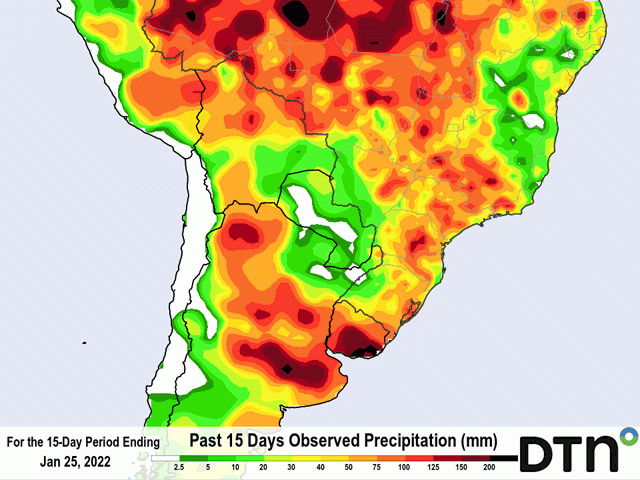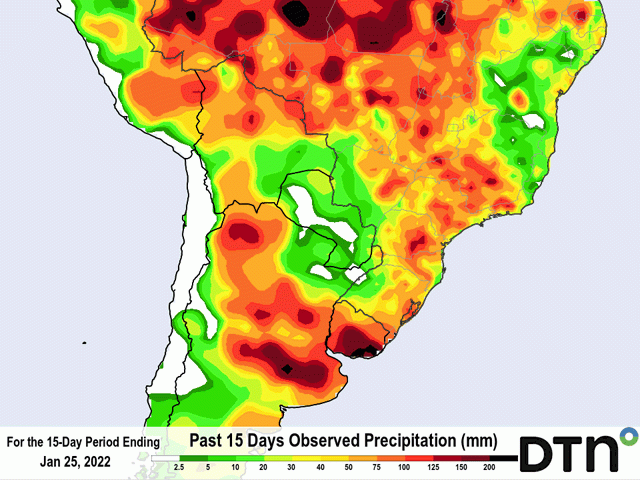South America Calling
A Recap of the Argentina Rains
In a break from the overall hot and dry La Nina pattern, Argentina picked up some very good rainfall between Jan. 15-26. Overall, rainfall totals in the heart of the main growing regions were widespread in the 75- to 150-millimeter (roughly 3- to 6-inch) range during that time frame. And there have been isolated cases up and over 200 mm (roughly 8 inches) where rains were even more persistent.
Rainfall that heavy can lead to some detrimental flooding in spots, but overall, due to the overall dryness that was witnessed before the rains came in, there was a lot of room for soils to soak the water up.
The rains led to significant improvements in crop conditions and soil moisture in Argentina, according to the Buenos Aires Exchange. In its report released on Jan. 27, good-to-excellent ratings for both corn and soybeans rose greatly, while poor ratings fell sharply during the last week. For corn, good-to-excellent ratings rose 10 percentage points to 32%, while poor ratings fell 9 percentage points down to 28%. For soybeans, good-to-excellent ratings rose 8 percentage points to 38% while poor ratings fell a similar 8 percentage points to 19%. For soil moisture, the amount of crop in drought also fell during the last week -- from 44% to 28% in corn areas and from 52% to 36% for soybean areas. There is still some room for improvement, and the drought is not over for everyone, but producers are definitely breathing a sigh of relief about the weather conditions from the last two weeks.
P[L1] D[0x0] M[300x250] OOP[F] ADUNIT[] T[]
While most of Argentina saw some really good rains, other parts of the continent did not. Far northern Argentina, Paraguay, and southern Brazil, which have also been dealing with drought for much of the season so far, did not partake in those rains. Instead, they were treated to very isolated showers or complete dryness, and temperatures exceeding 40 Celsius (104 Fahrenheit).
As rains left central Argentina Jan. 26, they moved through Paraguay and southern Brazil, where 25 to 75 mm of rain were noted and not shown in the attached image. Those rains continue for another couple of days before they, too, head farther north into central Brazil.
This part of the world has seen crop conditions falling while Argentina has seen them rising. Deral, the department of rural economics in Brazil, recently rated soybeans in Parana, Brazil as 31% poor and 36% good. In Rio Grande do Sul, Brazil, those ratings were fairly similar at 31% poor and 33% good. And while these ratings are similar to the ones in Argentina, the time left for the crop is different. Soybeans are nearing the end of their life cycle in Brazil, as they were planted in October and at or nearing maturity. Argentina's farmers did not start planting their soybeans until November and much of the crop was held off until December or January because of the dryness.
The rains that occurred Jan. 26 and continue through Jan. 28 will help to stabilize crops. But the wet period is over for southern South America and La Nina has returned to cause concern for producers.
The good part is that while the dry pattern will be in place for what looks like several weeks, it will not be completely dry like we saw in early January. There are several systems that will move through with scattered showers. But they will follow the La Nina script of being quick-moving, scattered, and brief. This will lead to lower-than-normal rainfall amounts across the region. However, if they come with at least some regularity, the timing may be more important than the overall amounts. That is especially true with regards to southern and central Argentina, where soil moisture profiles are full enough to handle some drier stretches.
But there is a long way to go yet this season. Some of the corn crop in Argentina has yet to be planted and most of the safrinha (second-crop) corn in southern Brazil is still awaiting producers as well.
To find more international weather conditions and your local forecast from DTN, head over to https://www.dtnpf.com/…
John Baranick can be reached at john.baranick@dtn.com
(c) Copyright 2022 DTN, LLC. All rights reserved.






Comments
To comment, please Log In or Join our Community .